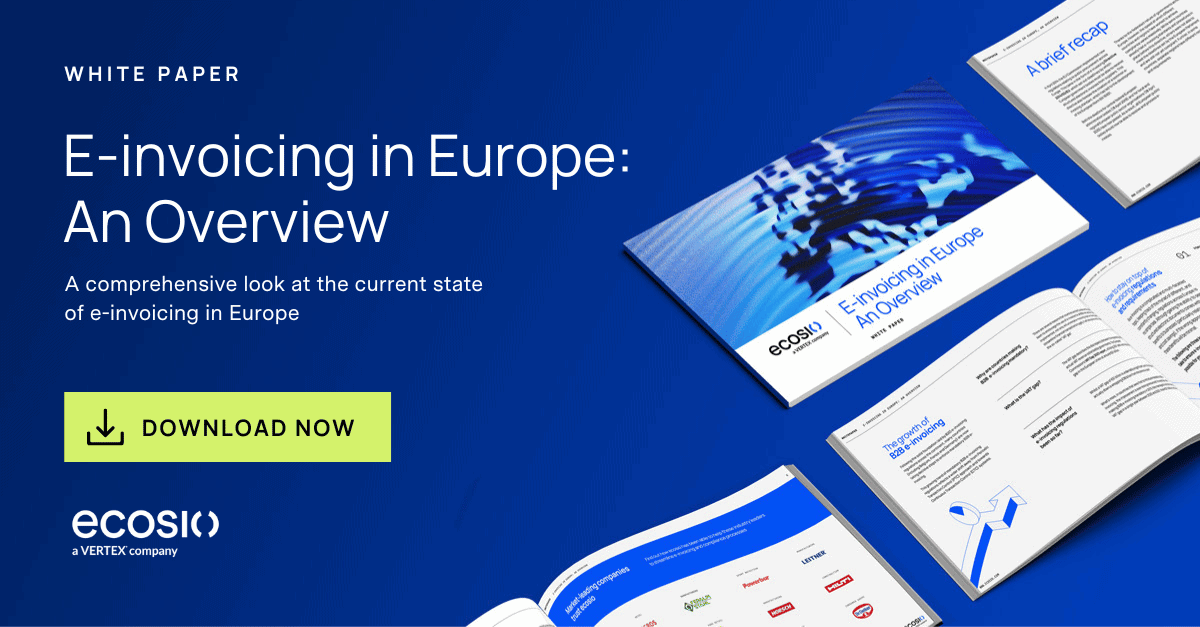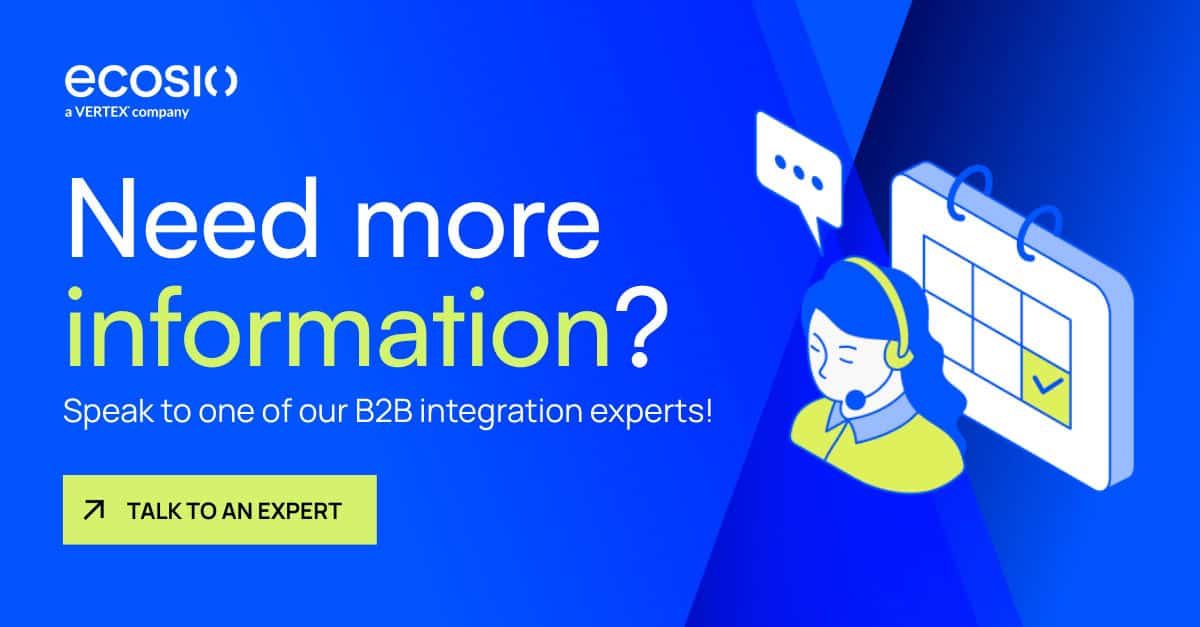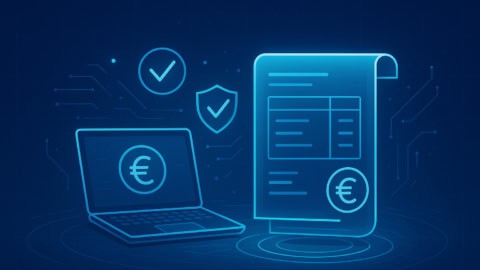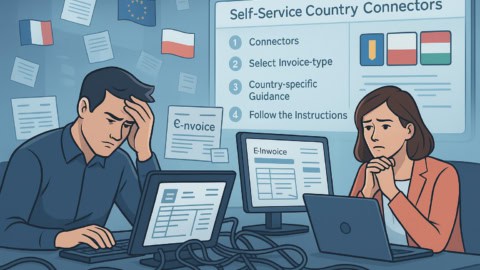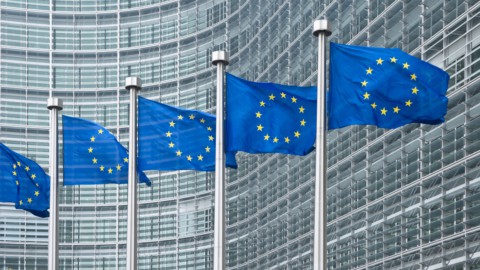With more and more countries introducing e-invoicing regulations, selecting efficient e-invoicing software is a key concern for many businesses today.
While exchanging paper or PDF invoices with partners may have been sufficient in the past, this is now no longer the case. In order to help fight VAT fraud and improve the reliability of B2B communication, Governments across the world are requiring businesses to be able to send and receive e-invoices.
In the long term, exchanging automated messages with partners via e-invoicing software will bring many benefits. However, in the short term, identifying and implementing an e-invoicing software solution can be a stressful experience. What’s more, this process is often prompted by an upcoming deadline, meaning there is generally limited time to explore all the possibilities.
To help, in this article we’ve broken down the process of selecting a suitable e-invoicing software and what each solution type requires.
What does e-invoicing software do?
E-invoicing software enables businesses to send order and invoice information to business partners automatically. These messages are formatted in specific computer-readable languages which allow the receiver’s system to extract the relevant information without any need for human intervention (and thus less chance of errors). When an invoice is sent using this method, known as electronic data interchange, or EDI, the receiver sees the information directly in their ERP system or accounting software.
The main two technical tasks that all e-invoicing software must be able to do are mapping and routing.
Mapping
Mapping refers to the process of converting the information in an invoice (or other business document, e.g. purchase order) into a particular encoded file format. Common formats include EDIFACT, ANSI ASC X12, TRADACOMS, VDA and UBL.
Typically the required format is specified by the customer and is communicated via a message implementation guideline, or “MIG”.
Routing
Routing involves the sending of the encoded message via an agreed protocol to ensure it is successfully received. Popular e-invoicing protocols include HTTP, AS2, OFTP2 and REST API.
As with file formats, the method of transmission (AKA protocol) is typically specified by the customer in their MIG.
What e-invoicing software options are available?
Essentially there are two main options when it comes to e-invoicing software: in-house e-invoicing software, and external solutions.
In-house e-invoicing software
In-house e-invoicing software must be installed on your internal server. This type of solution typically involves a lower up-front cost, but requires a high amount of internal effort, as all mapping and routing must be managed by internal teams, as well as ongoing tasks such as message monitoring and error resolution.
For this reason, this approach generally only makes sense for those companies that already have substantial internal resources and EDI expertise.
External e-invoicing solutions
In contrast to in-house e-invoicing software, external e-invoicing solutions require little internal effort. Rather than having to be installed locally, these solutions are connected via the cloud. This way your provider is able to handle technical tasks for you, while you maintain end-to-end visibility of all relevant data being exchanged.
With ecosio, for example, there’s no need to undertake any mapping or routing yourself. All you need to do is tell us who you need to be connected to and we’ll handle everything for you, from initial onboarding right through to ongoing operation.
Plus, with such a solution you also get round the clock support from e-invoicing experts and a system that can evolve as your needs change over time.
Questions to consider when selecting an e-invoicing software solution
1) Do you have sufficient internal resources to operate an in-house solution?
While some local e-invoicing software solutions are certainly more user-friendly than others, all require a certain level of technical expertise to ensure successful operation. During onboarding, for example, in addition to setting up mapping and routing for each partner, it is necessary to conduct thorough testing before connections are put live if errors are to be avoided. Plus work is also required once connections are live, as exchanges still need to be monitored, errors corrected, and updates installed when appropriate.
As well as requiring technical knowledge, all of these tasks also take time. If you aren’t sure your internal team will be able to cope, opting for an external e-invoicing software solution is the sensible choice.
2) Is it important for different teams to be able to access data easily?
Given the significance of the data in e-invoicing messages, it can be useful for multiple internal departments (e.g. Purchasing) to have visibility of what has been exchanged. With local e-invoicing software solutions this can be difficult to achieve, as accessing this data may require the individual to log into a separate unfamiliar interface. For this reason, it is easy for IT to become a bottleneck when such solutions are used.
By contrast, with a good external e-invoicing solution relevant data can be accessed directly by whoever needs it in your existing ERP system. In particular, real-time visibility of message statuses can be extremely valuable to various teams.
3) Are your e-invoicing requirements likely to change over time?
From new partner onboardings to a demand for increasingly granular data from existing partners, there are many reasons that e-invoicing requirements can change over time. With this in mind, it’s important to ensure that your solution and the internal team responsible for overseeing e-invoicing are able to cope when requirements evolve.
4) Can you keep track of changing country-specific regulations?
Over the past decade countries across the world, and Europe in particular, have been steadily moving towards mandatory e-invoicing. Unfortunately, however, each country has gone about this project in its own unique way. While understandable, this lack of standardisation has resulted in a nightmare of constantly changing regulations for international businesses.
Consequently, it’s important that any business opting for an in-house e-invoicing software solution is both prepared to track legal developments proactively across relevant countries and capable of updating its solution accordingly.
For those opting for a cloud-based e-invoicing solution, this is less of an issue, as updates can be implemented automatically by the provider on an ongoing basis.
5) How much risk are you willing to take?
Naturally, running anything in-house comes with a certain level of risk. When it comes to e-invoicing software, one of the main risks is the dependence of such a key business process on the expertise of a few individual employees. As e-invoicing requires technical knowledge, tasks are often handled by a small number of internal specialists. This leaves processes vulnerable to disruption should these individuals leave or become sick.
Another danger of handling e-invoicing in-house is the risk of significant data loss due to a lack of redundant infrastructure. Given the significance of the data being exchanged, loss of this data due to a server issue can be catastrophic. As a result, it is wise for businesses that don’t operate a redundant infrastructure to opt for an e-invoicing software solution that does.
What benefits can an efficient external e-invoicing solution deliver?
For those businesses that choose the right e-invoicing software solution, the potential benefits are numerous. Among other advantages, choosing a solution that matches your internal capability can provide…
Peace of mind
Staying on top of e-invoicing regulations, setting up connections and constantly monitoring B2B exchanges can be difficult – particularly for individuals lacking EDI experience. By outsourcing responsibility for your e-invoicing processes, internal teams can focus on what they do best, safe in the knowledge that e-invoicing is in good hands.
Time and cost savings
When a business opts for internal e-invoicing software, technical tasks typically fall to individuals who have many other responsibilities. With an external solution these tasks are handled by experts who are able to complete them much faster. Meanwhile, not needing to implement, operate and update software in-house also allows for significant cost savings.
Better visibility
By utilising an API connection, an external solution can be integrated into your existing ERP system in such a way that they provide end-to-end data visibility within your current UI. In these solutions key e-invoicing data is no longer a black box, but is instead accessible to all relevant parties. Further, real time visibility of message statuses allows for faster and more efficient partner exchanges, as well as quicker error resolution times.
Improved partner relationships
The more efficient your e-invoicing solution, the better you will be prepared to connect to new partners and the stronger existing partnerships will become. For this reason, streamlined B2B processes are particularly important for growing businesses.
Increased flexibility
As any adaptations to in-house software need to be managed internally, it’s easy for local solutions to become out of date. With cloud-based e-invoicing software there’s no such issue as your solution can easily be adapted to suit your needs – with no internal effort needed. Whether you need to route messages via a new protocol, connect to a particular VAN, or achieve compliance with new e-invoicing regulations, your solution can be updated remotely to ensure your business is able to continue to grow.
Interested in making e-invoicing hassle-free?
At ecosio we’ve helped hundreds of businesses to streamline their B2B processes via our futureproof e-invoicing solution, and know exactly what successful e-invoicing entails.
With ecosio’s cloud-based, E-invoicing as a Service approach, you barely need to lift a finger to benefit from reliable, automated partner connections and full compliance with complex, country-specific regulations. In short, we take care of all the technical stuff so you can focus on what you do best!
By connecting to your system via API, ecosio’s solution also offers industry-leading data visibility, ensuring that delivery statuses are displayed directly in your existing ERP interface and can be accessed by all relevant parties.
For more information, feel free to get in touch. Our experts will be more than happy to help you eliminate your e-invoicing issues.


